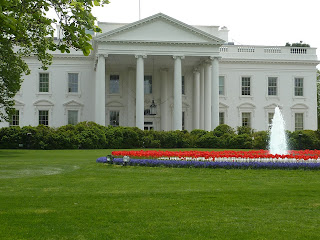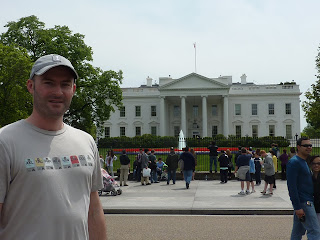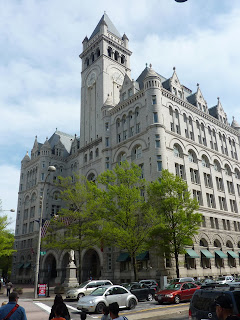 Friday
FridayOn Good Friday we flew from London Heathrow to New York Newark airport for a week-long trip to the USA. We arrived at Newark at around midday local time and caught a train down to Washington DC. It was a bit of a mission actually getting from the airport to the train - we had to take the "Air Train" from our terminal to the airport train station and then we had to take a six minute train ride from the airport train station to Newark Penn Station, where we caught a proper train down to Washington DC.
Newark Penn Station was a scary place - we were possibly the only people in the whole station not high on something and we seriously feared we would be mugged. But we managed to escape unharmed and our train down to Washington DC was actually very comfortable and the ride was enjoyable. We passed through the states of New Jersey, Pennsylvania, Delaware and Maryland, getting glimpses of Philadelphia and Baltimore, before eventually hitting the District of Columbia. The journey took around 2.5 to 3 hours.
The Constitution of the United States, ratified in 1788, allowed for a seat of government, not to exceed 10 square miles, which would be ruled by Congress. This area was to be independent and not part of any state. After some debate about where this seat of government should be located, George Washington chose an area that incorporated land from both Maryland (in the north) and Virginia (in the south) and included the towns of Alexandria and Georgetown. It was to be known as the city of Washington and the District of Columbia (DC).
We arrived in Washington and made our way from the beautiful Union Station to the Quincy Hotel. Many of the streets in central Washington are conveniently named by number (vertical streets) and letter (horizontal streets). Our hotel was situated on L Street, between 18th and 19th streets. We got settled in there and got ourselves looking respectable and then headed out for some dinner. By the way, the Quincy Hotel was amazing and we would definitely recommend it. They had the most comfortable and enormous bed in the world!
Unfortunately it was a wet and chilly evening in Washington DC, but we braved the weather and made our way to the Old Ebbitt Grill, one of Washington's favourite eateries since 1856. It was a really fun place. We sat on stools at the bar and we were served by a waiter called Sean, who entertained us throughout the evening. We tried a couple of local beers and a Brooklyn Lager, which were very nice, and we shared some buffalo wings for a starter. Then Tim had a "Po Boy" fried oyster sandwich and Megan had a local delicacy of crab cakes. All of the food was amazing. We were pretty knackered after a 23-hour day, so after dinner we headed back to the hotel and crashed.
Saturday
We had heard that to do a tour of the US Capitol building, you had to get down there early and queue up for tickets. So we got cracking pretty early and, after a delicious breakfast at a cafe/bakery across the road from our hotel, we headed for Capitol Hill.
The US Capitol building is one of the world's best-known symbols of democracy. The centre of America's legislative process for over 200 years, its Neoclassical architecture reflects the democratic principles of ancient Greece and Rome. The cornerstone was laid by George Washington in 1793, and by 1800 the Capitol was occupied. The British burned it down in the War of 1812, but restoration began in 1815.
One wing houses the Senate Chamber, the opposite wing contains the House Chamber. The lower house of Congress, the House of Representatives, contains 435 members, who each represent a district and serve a two-year term. House seats are apportioned among the states by population in much the same way as New Zealand's constituent seats in Parliament, meaning that the densely populated states have more representatives than the sparsely populated states. However, in the upper house of Congress, the Senate, each state, regardless of population, has two senators, making a total of 100 senators, who each serve six-year terms.
The Rotunda was completed in 1865, is 55 metres high and its interior is beautifully decorated, and is capped off with The Apotheosis of Washington, a fresco by Constantino Brumidi. Sitting proudly on top of the dome is the 6-metre tall, 6,800kg bronze Statue of Freedom, which was added in 1863. Not only representing the legislative heart of Washington, the Capitol building also marks the precise centre of the city. The city's four quadrants radiate out from the middle of the dome of the building.
We managed to get down to the Capitol building visitor centre fairly early and we did not have to wait long before joining a tour of the building. The tour lasted around 45 minutes and was really interesting. Sadly, since it was a weekend, we were not able to see inside the Senate Chamber or the House Chamber, but we did visit the huge rotunda, which is decorated with statues of former presidents and other famous people.
In 1864 Congress invited each state to contribute two statues (which are often updated or exchanged over time) of prominent citizens to stand in the halls of the Capitol. It was a little odd that there were statues of presidents all through the Capitol building, since the tour guide emphasised the fact that presidents very rarely set foot inside the building once they take office, and only ever when invited by Congress to do so, as a symbolic gesture of the separation powers between Congress (legislature) and the President (executive).
After our tour of the Capitol building, we headed next door to visit the Library of Congress. Congress first established a reference library in 1800. When the Capitol was burned in 1812, Thomas Jefferson offered his own extensive collection as a replacement. In 1897, the Library of Congress moved to a new Italian Renaissance-style building, a marvel of art and architecture, with its paintings and mosaics and several exhibitions. The Library of Congress has the world's largest collection of books and materials.
We guided ourselves around the beautiful Library of Congress, visiting the Great Hall, with its grand staircases and bronze statues, the Main Reading Room, the stunning mosaic of Minerva, the display of the Gutenberg Bible, and the exhibitions on the Thomas Jefferson Library collection. It is a truly amazing building - see photos below.
We were getting pretty hungry so we decided to head down Pennsylvania Avenue and grab some lunch. We found a restaurant/bar called The Laughing Man. Tim had a BBQ pulled pork sandwich and a bottomless coke and Megan had vege burger. Good solid American food! The Laughing Man is just a stone's throw from the White House, so we rather excitedly headed there after lunch!
The White House is the official residence and principal work place of the President of the United States. The White House was built on Washington DC's Pennsylvania Avenue between 1792 and 1800. It has been the residence of every president since John Adams. During the War of 1812, the British burned the White House, destroying the interior. Reconstruction began almost immediately.
The White House has been expanded gradually over time, with the West Wing being added in 1901, followed by an expansion of the West Wing and the creation of the first Oval Office in 1909. In the 1920s and 1930s a new East Wing was constructed. By 1948, the house's load-bearing exterior walls and internal wood beams were found to be close to failure. Under President Harry Truman, the interior rooms were completely dismantled and a new internal load-bearing steel frame was constructed inside the walls. Once this work was completed, the interior rooms were rebuilt. Today, the White House is made up of six stories, including a two-storey basement.
We got a great view of the White House and took plenty of photos - see below. But we were eventually forced to leave by the incredibly annoying ranting of a weird guy with a megaphone. He was chanting a mixture of biblical references, well-known hip-hop lyrics and some other indecipherable jibber jabber - the price America pays for the freedom of speech...
A few blocks from the White House is the White House Visitor Centre, which contains interesting exhibits about the White House and its decor, the history of the White House, presidents and First Families who have resided there and a display of royal gifts. It also contains an excellent gift shop, where we purchased a great book on all of USA's 44 presidents.
The day had well and truly cleared from the grey and drizzly start and the afternoon was sunny and hot. We decided to take advantage of the nice weather and stay outdoors, so we caught the metro to the Arlington National Cemetery, which is south of the city centre and actually situated in the state of Virginia!
For 30 years, the Confederate General Robert E Lee lived at Arlington House. In 1861, he left his home to lead Virginia's armed forces, and the Union confiscated the estate for a military cemetery. By the end of the Civil War in 1865, 16,000 soldiers were interred in the newly consecrated Arlington National Cemetery. Since then, around another 250,000 veterans have joined them. Simple headstones mark the graves of soldiers who died in every major conflict from the Revolution to the present. The focus of the cemetery is the Tomb of the Unknowns, which honours the thousands who have died in battle but have no known resting place.
We slowly walked around the huge Arlington National Cemetery grounds, which were beautifully dotted with blossom trees in full bloom. Our first stop was the Grave of John F Kennedy. A flame lit by his wife, Jackie, on the day of his funeral in December 1963 burns here continually. Jackie and two of his children are buried alongside the former president. Excerpts of some of Kennedy's most famous speeches are etched into the surrounding walls.
Next we visited Arlington House, which sits on top of a steep hill in the middle of the cemetery, with amazing views over Washington DC. In front of the house is tomb of Pierre L'Enfant, the architect responsible for planning the city of Washington. From there we wandered across to the Memorial Amphitheatre, the setting for the annual services on Memorial Day. It has also hosted many state funerals.
Opposite the Memorial Amphitheatre are two memorials for the space shuttle tragedies. The Space Shuttle Challenger exploded shortly after lift-off in January 1986 and the Space Shuttle Columbia disintegrated during re-entry in February 2003. Seven astronauts died in each disaster.
Our final spot at the cemetery was the Tomb of the Unknowns. We were fortunate enough to witness the changing of the guard at the tomb. The tomb contains four vaults, one each for World Wars I and II, the Vietnam War and the Korean War. Each vault held one unidentified soldier, until recently, when the Vietnam soldier was identified by DNA analysis and reburied in his home town.
After leaving Arlington, we caught the metro across to the Pentagon, although disappointingly, we emerged from the metro rather close to the fence surrounding the Pentagon, too close to actually get a good view of it. The Pentagon is the headquarters of the US Department of Defence. Its construction was completed in January 1943. It is the world's largest office building by floor area, with about 604,000 square metres. Approximately 23,000 military and civilian employees and another 3,000 non-defence support personnel work in the Pentagon. It has five sides, five floors above ground (plus two basement levels), and five ring corridors per floor with a total of 28.2 km of corridors.
We rested back at the hotel for a while before heading down to a tex-mex restaurant called Tortilla Coast, in the Capitol Hill area, for dinner. Apparently it was regularly frequented by George W Bush before he became president. The food was delicious, the servings were huge and the service was superb. After dinner we walked back past the Capitol building, which was beautifully lit up, to the metro and headed to the hotel to crash. It was another huge day and we were knackered.

Capitol
building

Inside
the dome

The
dome

Megs with
Ronald Reagan
statue

George
Washington

Capitol

Library of
Congress

Main
reading
room

White
House!


Old Post
Office

Statue of
Benjamin
Franklin

Arlington
House

JFK's
eternal
flame

View
from
Arlington
Cemetery

Arlington
graves

Memorial
Amphi-
theatre

Space
Shuttle
memorial

Tomb of
Unknown
Soldiers

Capitol
by night














